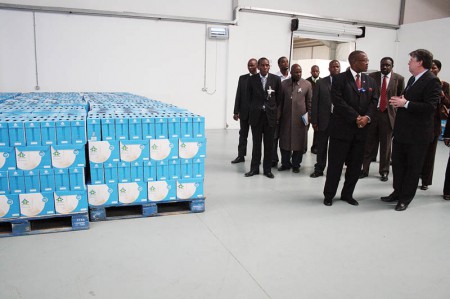The infant that refuses to grow
Brian Benza | Friday March 13, 2015 15:48


This has been seen with countries such as England over 300 years ago, and the industrialisation boom of economies such as the US, Germany and Japan in the 19th century.
Even with emerging 21st century economic powerhouses such as China, which is now the world’s largest manufacturing nation having overtaken USA in 2010, growth in physical volumes of manufacturing has been the key to prosperity.
In the words of a famous Norwegian economist, Erik Reinert, the strength of a country’s manufacturing sector is the difference between rich countries getting richer and poor countries staying poor.
While Botswana, thanks to the discovery of diamonds in the 1960s, has managed to escape the poor countries status, the economy has thus far depressingly failed to develop a sustained manufacturing sector, to the detriment of diversification efforts.
Despite government efforts in promoting the manufacturing sector, it remains in an ‘infancy stage’, contributing significantly little to the economy.
Latest Statistics Botswana figures show that manufacturing contributed a mere 5.1 percent to Gross Domestic Product (GDP) as at September 2014 down from 5.6 percent in 2004.
This is in direct contrast to other sectors such as finance, which has grown from a 12 percent contribution in 2004 to 16 percent in 2014, and trade, which grew from 11 percent to 15 percent over the same period.
Dominated by industries such as meat processing, beverages, textiles and of late diamond cutting and polishing, the manufacturing sector is worth a mere P6.1 billion from the total GDP value of P124 billion.
Through quasi-state organisations such as Botswana Development Corporation (BDC) and Citizen Entrepreneurial Development Agency (CEDA) government has attempted to promote the sector for the past three decades.
But instead the path to industrialisation has instead been littered with numerous closures and failures of companies that were supposed to drive job creation and economic growth.
Among some of the collapsed ventures that government had pumped money into in the recent past include the Palapye Glass project where over P400 million was lost.
BDC also has high investment but failed projects, which include Lobatse Tile (P170 million), Golden Fruit (P24 million) and the Hyundai plant (P85.6 million).
In Selebi Phikwe, an attempt to incentivise investors through the Selebi Phikwe Regional Development Programme (SPRDP) ended with familiar disastrous results 26 years ago.
Through a Special Incentive Package for Selebi Phikwe offering a corporate tax rate of 15 percent for 20 years compared to the then national corporate tax rate of 40 percent, as well as exemption from withholding tax on dividends for 10 years, the SPRDP managed to attract 17 manufacturing firms in Selebi Phikwe creating 4,048 new jobs by the end of 1995 and a cumulative total of 6,315 jobs by January 1998. However, according to a report by consultants engaged by the government to study the potential for economic diversification in the town in 2006, the quality of jobs created was very low in terms of sustainability and lifespan.
By 1992, four of the 17 firms had closed and by 1998 only five of the original 17 were still in operation. The SPRDP was terminated in 1996.
Not only have the investors into manufacturing had their fingers burnt while attempting to produce for the external market, but also the inward looking industries have failed to either penetrate the local market or fend off competition from exports.
Economists point to Botswana’s high cost/low productivity operating environment as the chief cause of the sector’s demise.
Feeding into the high cost structure is the country’s high labour costs, high transport costs, absence of locally available raw materials as well high land and property costs.
According to a study on export diversification conducted by BIDPA, the skilled labour force in the non-mining private sector is highly paid compared to counterparts in the region, thereby eating into the rate of return for investing in Botswana and discouraging investments into the sector.
Because of the high-end wages, the products and services from Botswana are uncompetitive for the export market throwing spanners in the economic diversification efforts.
According to the results of the survey, the rate of return of investing in Botswana in comparison to the least cost producer, which was India in the sample survey found that on average labour costs contributed to a 54 percent difference between the two countries’ net present value of investments.
Evidence of Botswana’s comparatively higher labour costs has come out in the local diamond manufacturing industry where it is estimated that diamond-cutting costs are between $12 to $25 per carat in India, $20 to $30 in China and $60 to $65 per carat in Botswana.
Other constraints facing the sector include poor work ethic, small market size and lack of skilled labour, which affects development of new goods and markets.As part of the plans to revive manufacturing, government has in the past two years, through the Economic diversification Drive (EDD), developed strategies for the leather, dairy, textile and clothing industries.
According to the Botswana Investment and Trade Centre (BITC), which has been at the forefront of attracting investment into the country, opportunities presented by the manufacturing sector cover a wide array of sectors such as food and beverages, textiles and garments, jewellery making, metal and metal products amongst others.
At a national level, these opportunities are presented through the country’s high import bill, which stands at over P70 billion.
While the jury is still out on whether the new initiative will bear fruit after an unsuccessful period spanning over two decades, analysts agree that victory will hinge on the development and implementation of industrial policies that promote workplace productivity to increase profitability and growth for manufacturing start-ups.
